Introduction
This plan was originally prepared following a visit I made to Beidaihe in May 2005, at the request of Mr Cao Ziyu, Director of the People’s Government of Beidaihe. I revised it in May 2009, following a further visit to the town.
Here, “Beidaihe” covers the coastal area south from the Sandflats (Henghe) to the vicinity of the Yanghe – ie including Beidaihe Haibin (Beidaihe-by-the-Sea) and Nandaihe.
Though the emphasis here is on birds, conservation measures could achieve several positive outcomes, including:
• Direct conservation, especially of migratory birds including globally endangered species;
• Indirect conservation, such as through monitoring populations and population changes, and through conservation education;
• Enhancement of Beidaihe, by protecting and improving green spaces and so helping to keep Beidaihe a fine place to live in and visit;
• Boost to local tourism, partly through continuing birdwatching tourism, but mainly by creating additional attractions for people visiting Beidaihe chiefly for seaside holidays.
A Conservation Plan for Beidaihe, Hebei Province, China
– Beidaihe Can Create the World’s Most Exciting Reserve for Migratory Birds –
The recommendations given here are aimed partly at ensuring Beidaihe still has a good diversity of habitats, so continuing to attract a remarkably wide diversity of migrant birds. Habitat improvements could also increase Beidaihe’s relatively low diversity of breeding birds. [Note: unless otherwise stated, all photos were taken from 11-15 May 2005.]
There is an emphasis on wetland conservation. This is because wetlands are among the habitats most affected by China’s development, resulting in populations of several species falling in recent years, with some species now facing extinction. At Beidaihe, too, wetlands are shrinking; the proposals here could help slightly expand and improve wetlands at the town.
Woodland is also an important habitat; at Beidaihe, this is especially true in some coastal areas, such as along the south and east coast, and just south of the Yanghe – where woods afford cover for tired songbirds arriving from over the sea. Also, at the Lotus Hills, there is potential for nurturing relatively natural woods, with rich plant species diversity and greatly increased numbers and variety of breeding birds.
Perhaps the key recommendation is for a wetland reserve and visitor centre just south of the Henghe [Xinhe] reservoir. This could be based on a proposal by Ounsted (unpubl.). If successful, this could be a model for further such reserves coupled with visitor centres in the area – and, indeed, in other parts of China.
[header=Conservation at Henghe and Sandflats area]
The Henghe [=Xinhe] / Sandflats Area
– potentially the focus of birdwatching and bird conservation activities in northeast Hebei; especially as an important centre for conservation education, and nature tourism
Current Situation
This is a locally important, relatively large area with a mix of wetland habitats – including tidal sandflats, brackish marsh, reedbeds, a small reservoir, fish ponds, pools, creeks and marshes. There are also farm buildings, buildings associated with fishponds, the Qinhuangdao Bird Museum [new in spring 2009] and planted trees, including a new plantation on land that was formerly wetland (marsh with reeds).
The Beidaihe government has taken measures to protect this area, including by restricting major construction work, and employing people to guard against fires, and bird hunting. An extensive, maturing forest plantation extends along the coast north from here (in the 1940s, this was open, with sand dunes and small grassy marshes – attracting good numbers of birds including cranes).
However, in May 2009 it was evident too many trees had been planted, destroying areas of former wetland. Plus, even some areas where there was still water – in pools by the reservoir – were of little use for birds, as water levels were too high, shorelines too steep.
There are great opportunities for far better landscaping and management work, creating wetland areas that are highly attractive to wetland birds and other wildlife.
Just north of the reservoir, the plantation now holds a substantial egretry, with hundreds or thousands of nesting Little Egrets Egretta garzetta and Great Egrets E. alba and Black-crowned Night Herons Nycticorax nycticorax. Perhaps this egretry is of regional importance – perhaps one of the largest egretries in Hebei, or indeed along the coast of China (egrets were until recently scarce in much of China; numbers have increased – a welcome recovery towards the numbers in north China in the late 19h century).
General Recommendations
The habitats here should be protected as far as possible, with particular emphasis on wetlands.
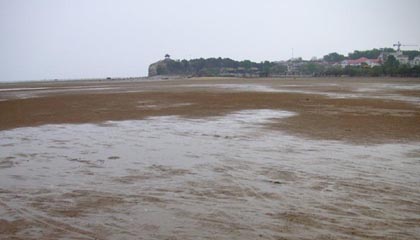 The Sandflats is a good area for coastal birds; globally threatened species occur here, including Chinese Egret E. eulophotes, Saunders’ Gull Larus saundersi and Relict Gull L. relictus.
The Sandflats is a good area for coastal birds; globally threatened species occur here, including Chinese Egret E. eulophotes, Saunders’ Gull Larus saundersi and Relict Gull L. relictus.
 Protection should include the relatively new brackish marsh and reedbeds of the western Sandflats: these hold a good variety of marsh birds. The nearby small plantation (just east of the highway) should also be retained; more trees/shrubs could be planted here to provide additional cover for migrant songbirds, which can occur here in fair numbers. While this wood is useful, most of the remainder of the area should be wetland.
Protection should include the relatively new brackish marsh and reedbeds of the western Sandflats: these hold a good variety of marsh birds. The nearby small plantation (just east of the highway) should also be retained; more trees/shrubs could be planted here to provide additional cover for migrant songbirds, which can occur here in fair numbers. While this wood is useful, most of the remainder of the area should be wetland.
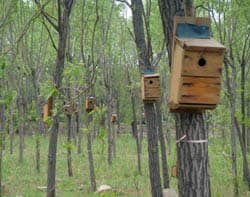 Many nestboxes but no birds! beside the museum. A wetland would attract far more birds, and would have far more conservation value
Many nestboxes but no birds! beside the museum. A wetland would attract far more birds, and would have far more conservation value
By May 2009, some of the wetland at the southern Sandflats had been damaged or destroyed. This was partly through tree planting.
This area is primarily important as a wetland – there are many trees in and around Beidaihe. Further, most of the endangered bird species occurring at Beidaihe are wetland birds, reflecting the great importance of protecting and even improving wetlands in this area.
Wetland should be protected, restored, and enhanced
Hence, ideally, several areas of trees should be cleared, and restored as wetland. This will require some landscaping work, such as excavating at least one shallow, tidal lagoon, together with creeks and channels. Importantly, the shorelines should be very gently sloping, with shallow silt/mud/sand: steep shorelines are typically of little value to wildlife.
There is scope for creating a wetland habitat, with expansive views northwards, in front of the bird museum. This will be vastly richer for birds than the few trees that had been planted here. Plus, these views will allow museum visitors a chance to see passing migrants, including cranes and storks.
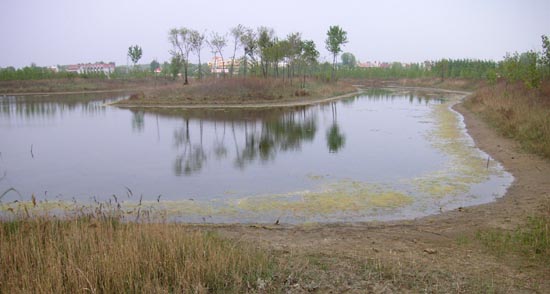 Likewise, protect the pools, creeks, and marshes beside – and especially north of – the reservoir. To ensure the freshwater character is retained, some trees may need felling; new tree planting should be discouraged. (There is a small plantation on land that a few years ago was rice paddy – and was a good area for wetland birds, which can no longer use the land.)
Likewise, protect the pools, creeks, and marshes beside – and especially north of – the reservoir. To ensure the freshwater character is retained, some trees may need felling; new tree planting should be discouraged. (There is a small plantation on land that a few years ago was rice paddy – and was a good area for wetland birds, which can no longer use the land.)
Reserve and Visitor Centre
In the late 1980s, a plan was drawn up for a small wetland reserve with visitor centre, just south of the reservoir, and close to the Beidaihe–Qinhuangdao highway (Ounsted, unpubl.: copy just sent to Beidaihe govt [was also given to the govt in late 80s]). Indeed also in the late 1980s, the Beidaihe government established a bird reserve here; however, with no funding, the reserve was ineffective, and the area deteriorated, partly as farm buildings were constructed on this and adjoining land.
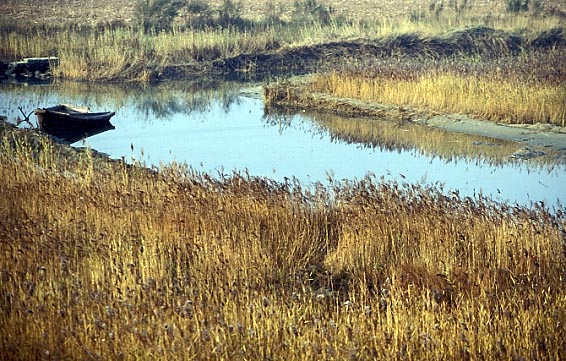 Reserve area in late 1980s.
Reserve area in late 1980s.
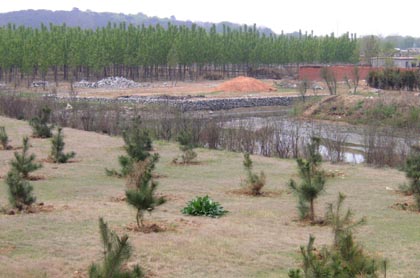 Former reserve area in May 2005. Note that trees had been planted; these had grown significantly by May 2009, so there has been further loss of wetland, to far less valuable secondary woodland. Though green, the trees here are of little benefit to wildlife; their function is mainly cosmetc.
Former reserve area in May 2005. Note that trees had been planted; these had grown significantly by May 2009, so there has been further loss of wetland, to far less valuable secondary woodland. Though green, the trees here are of little benefit to wildlife; their function is mainly cosmetc.
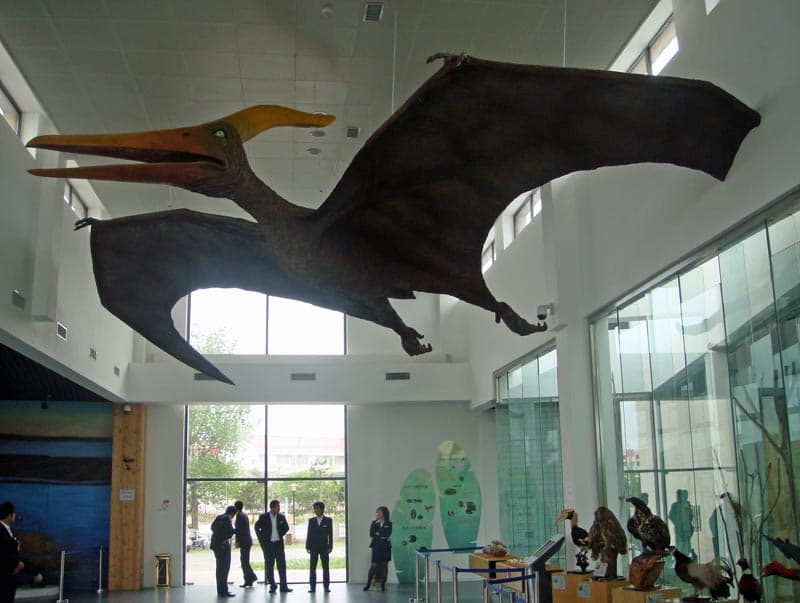 There does, however, still seem to be potential for creating the reserve and visitor centre, much as envisaged by Ounsted. May 2009: with the bird museum now established, it may be possible to transform this into a visitor centre as Ounsted envisaged. This would involve changing the museum’s focus from sterile images and dead birds – and dinosaurs!!, to an emphasis on wild birds, flying free – and far more exciting than any computer image or model.
There does, however, still seem to be potential for creating the reserve and visitor centre, much as envisaged by Ounsted. May 2009: with the bird museum now established, it may be possible to transform this into a visitor centre as Ounsted envisaged. This would involve changing the museum’s focus from sterile images and dead birds – and dinosaurs!!, to an emphasis on wild birds, flying free – and far more exciting than any computer image or model.
The “reserve” land has recently been changed: it’s now drier, with a stream that once partly flooded the area constrained by artificial banks; there is a small, new plantation. The farm buildings remain. However, it should be possible to restore and greatly enhance the wetland character of this area – such as by excavating a shallow lagoon, partly fed by the stream. This will involve removing more farm buildings; in May 2005, the Beidaihe government had recently demolished 11 buildings in this area, with compensation to farmers (the buildings were all only “temporary” – as I was informed in the late 1980s).
By May 2009, there was a small park with trails and bridges past and over pools and creeks along the south shore of the reservoir. I visited only briefly, but while the area looked pleasant for human visitors, it was less impressive for birds. For instance, a pool with a zigzag bridge and pavilion had steep sides: yet with muddy margins it could hold fair numbers of birds. Making the park pleasant for people and attractive to birds should be possible: indeed, with more birds, the park would be more attractive to people.
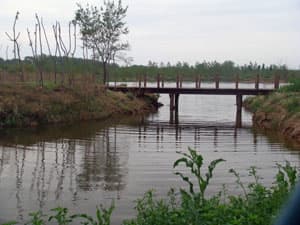 Pool north of the reservoir, by highway to Qinhuangdao. Had been very good for birds; near useless in May 2009 as water levels too high, shorelines too steep. Planted trees destroying open areas, inc wetland
Pool north of the reservoir, by highway to Qinhuangdao. Had been very good for birds; near useless in May 2009 as water levels too high, shorelines too steep. Planted trees destroying open areas, inc wetland
Also in 2009, work was underway in the area north of the reservoir, which had been fenced off, with no visitor access. Looking in through the fence, it was evident many trees had been planted – again, destroying wetland. Plus, a pool by the highway that had been very attractive to birds in recent years, thanks to its shallow muddy shorelines and small muddy islets, had been made virtually useless to birds – with steep shores, and water levels that were too high. I heard this was a nature/bird reserve: if so, it may have been established with good intentions, but landscaping and management work seem intent on designing a place for humans, not somewhere for nature including birds.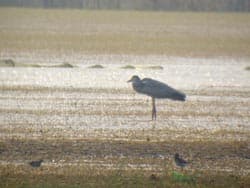 Shallow water, gentle shorelines – and freshwater wetland birds – at Tianmahu, west of Beidaihe
Shallow water, gentle shorelines – and freshwater wetland birds – at Tianmahu, west of Beidaihe
A wetland reserve with visitor centre should hold very good numbers of birds, with an impressive species variety. And, it could become a significant attraction for people: residents of the Beidaihe/Qinhuangdao area; schoolchildren on educational visits; tourists visiting Beidaihe primarily for beaches etc; and birdwatchers from China and overseas. It would also enhance Beidaihe – for instance, complementing the partly wooded, nearby Olympic Park.
The reserve might be like Minsmere – a coastal wetland reserve in the UK that holds good numbers of birds, and is very popular with visitors. Minsmere could be an excellent model for Beidaihe to consider, along with Hong Kong’s Mai Po Marshes (which was in turn partly modelled on Minsmere) But the Beidaihe reserve would have a greater variety of species, with more endangered species perhaps visiting; and could attract far more visitors.
Even if initially small, the reserve and visitor centre should be designed and build with the potential for expansion in mind. If the reserve is indeed a success with visitors, it should generate income, which can in turn be used to expand the area of managed wetland habitat, and to expand and improve the visitor centre and facilities (including by adding more trails, and hides [blinds] for watching birds).
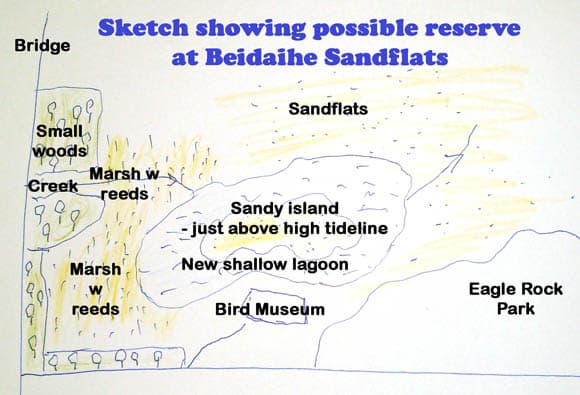
Possible brackish/saltwater reserve at the Sandflats. For sketch of potential – and complementary – freshwater reserve south of the reservoir, see Ounsted (unpubl.).
Potentially, a reserve including the Sandflats and reservoir area could be the world’s most exciting reserve for migratory birds – with high species numbers, birds present changing rapidly on some days, and overflown by many tens of thousands more birds, including eagles, cranes and storks.
It will not be just for specialist birdwatchers: with many birds present, and good facilities, it will be a great place for Beidaihe/Qinhuangdao people, as well as an additional tourist attraction.
Note these suggestions do not mean the reserve must exclude people from the area; at the Sandflats, especially, this would be difficult or impossible, and surely unpopular with local people and tourists! Instead, access might be restricted to one or more areas.
If successful, it should be a model for creating more, similar reserves and visitor centres in China – where the time is surely right for developing reserves that help bring wildlife and people closer.
Even if initially small, the reserve and visitor centre should be designed and build with the potential for expansion in mind. If the reserve is indeed a success with visitors, it should generate income, which can in turn be used to expand the area of managed wetland habitat, and to expand and improve the visitor centre and facilities (including by adding more trails, and hides [blinds] for watching birds).
It may also be useful to feed birds, such as by putting out grain (not quite good enough for human consumption) for ducks, perhaps geese and other birds.
Staffing considerations are included in Ounsted (unpubl.). Maybe staff could include some of the local farmers, especially fish farmers – who should have some experience in controlling water levels. Perhaps, too, some fish can be raised within the reserve – though not if this has a negative impact on wildlife.
The museum evidently has a sizeable staff. In May 2009, I did not gauge how knowledgeable they were regarding birds, and wildlife conservation. If there is a change of emphasis to wild birds, some training might be advisable – and the change should make working at the museum far more interesting and rewarding. Plus, specialist staff members should be recruited: people who know wild birds.
Some Target Species
Birds that might use a small wetland reserve – a pool with shallow margins, with some reeds, and some muddy margins – should include various bitterns, herons and egrets, ducks, shorebirds, terns, kingfishers, reed-warblers and buntings. Small parties of geese and cranes may also occasionally visit during migration (especially north of Beidaihe, there is little good habitat for these and many other waterbirds). Based on observations in this area, there could be species of conservation concern, some of which are internationally endangered, such as: Screnck’s Bittern Ixobrychus eurhythmus, Mandarin Duck Aix galericulata, Baikal Teal Anas formosa, Baer’s Pochard Aythya baeri, Japanese Marsh Warbler Megalurus pryeri, and Streaked Reed-Warbler Acrocephalus sorghophilus. Other notable species – especially those preferring coastal wetlands – occur at the tidal Sandflats.
A larger wetland reserve, extending across much of the low-lying land south of the reservoir (and, ideally, also including the reservoir and the marshy land just to the north) would attract higher numbers of birds, and should prove more attractive to several larger as well. There is strong evidence of this from observations during the 1940s at the “Grassy Sands” (now a plantation) that once extended north towards Qinhuangdao: notable records here included single flocks of 1000-1500 Oriental White Storks Ciconia boyciana, 500-1000 Bean Geese Anser fabailis, and 400-500 Great Bustards Otis tarda (while not a wetland bird, the bustard frequents grasslands, including those fringing wetlands) (Hemmingsen, 1951, Hemmingsen & Guildal, 1968).
[Header=Protecting Other Sites in Eastern Beidaihe]
Other Sites in Eastern Beidaihe
Eagle Rock
Eagle Rock (Pigeon Nest) is already a small park, and is a good site for observing birds: it affords a fine vantage over the Sandflats and the sea; visible migration may be evident, especially in autumn; and songbird migrants occur in the trees and shrubs.
The park should retain the trees and shrubs, including the scrub along the westen slope of the “rock”.
Eagle Rock Gully
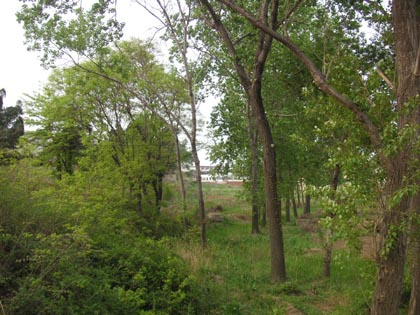 This is a small gully, with a little farmland and an orchard, south of Eagle Rock. It attracts migrants including songbirds.
This is a small gully, with a little farmland and an orchard, south of Eagle Rock. It attracts migrants including songbirds.
There is rather little cover in the gully now; to enhance its attractiveness, some more small trees and bushes could be planted/encouraged to grow in the lower part of the gully, nearest the road. (On land that is not used for farming/ fruit trees.)
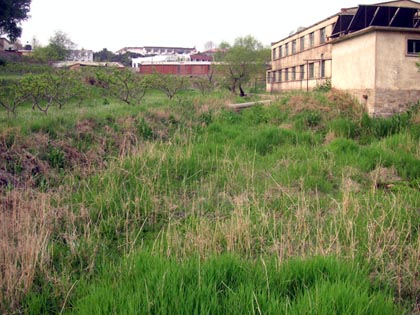 There is a small, marshy creek. The small pools and wet grass should be retained, but rubbish can be cleared from these; the creek should not be a dumping ground for refuse.
There is a small, marshy creek. The small pools and wet grass should be retained, but rubbish can be cleared from these; the creek should not be a dumping ground for refuse.
Lighthouse Point
This is evidently a former naval base, now used for holidaying naval officers. With open green spaces and many trees, it is rather like a de facto reserve – especially given its location on Beidaihe’s most prominent headland, which makes the point a major site for songbirds and other landbird migrants arriving from over the sea.
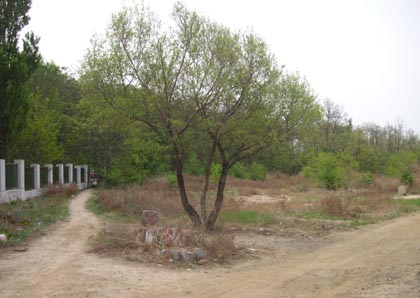 Presently, it appears the only public access is along the west coast of the point, where a track is mainly used by fishermen. This track has been expanded to allow four-wheel vehicles, and there is now a rough car park – which has destroyed much of the long grass and scrub that afforded cover for migrant birds. The woods here are, however, still intact.
Presently, it appears the only public access is along the west coast of the point, where a track is mainly used by fishermen. This track has been expanded to allow four-wheel vehicles, and there is now a rough car park – which has destroyed much of the long grass and scrub that afforded cover for migrant birds. The woods here are, however, still intact.
As well as protecting the habitats, it would be useful if birdwatchers could gain increased access to the point – at times when this would not inconvenience operations. (Such as when the holiday homes are not in use; they are reportedly for rent to the public during winter, so public access is at least sometimes possible without being disruptive.)
[By spring 2005, there was a new wall on the point, which further restricted public access – without clear benefits to naval staff.]
“Jin Shan Fields”
This is a former archaeological dig site, with the foundations of a small summer “palace”, just east of the Jin Shan Hotel. Mostly cleared of vegetation, it is attractive to some birds of open country, including some species that are scarce or rare at Beidaihe.
Legation Gully
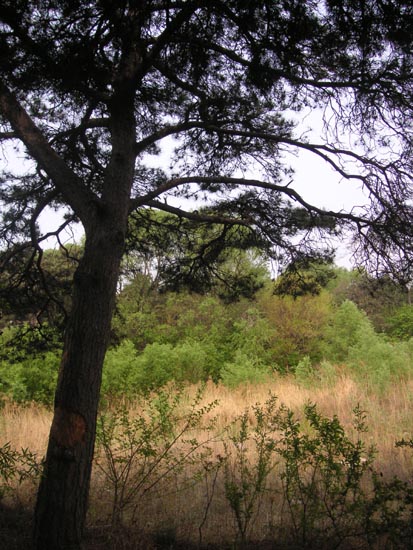 This is a small gully leading north from the coast just west of the Jin Shan Hotel. With trees, scrub and rank grass, and few people, it is a haven for migrant songbirds, and can be a very pleasant place for birdwatching.
This is a small gully leading north from the coast just west of the Jin Shan Hotel. With trees, scrub and rank grass, and few people, it is a haven for migrant songbirds, and can be a very pleasant place for birdwatching.
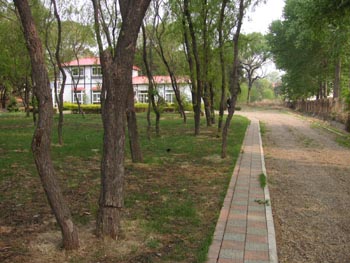 By May 2005, access to the gully had been severely restricted, as a large house with driveway had been built in the lower part of the gully. However, just above this house, a wider part of the gully remained well vegetated.
By May 2005, access to the gully had been severely restricted, as a large house with driveway had been built in the lower part of the gully. However, just above this house, a wider part of the gully remained well vegetated.
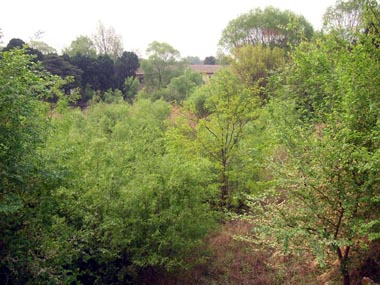 The remaining “wild” stretch of gully should be protected, as a sanctuary for migrant songbirds along Beidaihe’s southern coast; it’s of few remaining places along this coast where migrants can find dense vegetation, and relative tranquillity. (There were formerly more such gullies, notably “Study Gully”, which has lately been occupied by at least one building.)
The remaining “wild” stretch of gully should be protected, as a sanctuary for migrant songbirds along Beidaihe’s southern coast; it’s of few remaining places along this coast where migrants can find dense vegetation, and relative tranquillity. (There were formerly more such gullies, notably “Study Gully”, which has lately been occupied by at least one building.)
Access could be made possible again – such as by creating a narrow path from the coast road.
Olympic Park
This is a new park, just to the north of town. I didn’t have time to visit, but viewed whilst driving past. With many trees, and grassy areas, it will attract birds. It could be made more attractive if in places there is some dense cover – such as shrubs beneath trees; probably best if native species are planted. Shrubs that have berries in late autumn could be useful for birds such as Bohemian Waxwing Bombycilla garrulus and Japanese Waxwing B. japonica (the latter is scarce at Beidaihe; near-threatened worldwide).
More Cover in Gardens
n May 2009, it appeared there may be significant problems with migrant songbirds such as thrushes and robins, with many evidently falling prey to magpies. Usually, magpies are not able to catch and eat wild birds, but it may be that at Beidaihe they have learned how to chase and catch songbirds – including by chasing them into windows; if so, this my account for magpies now being super abundant in Beidaihe.
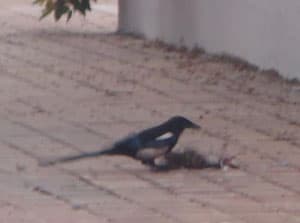
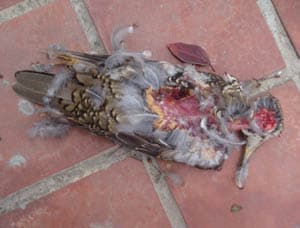 Magpie eating White’s (Scaly) Thrush that had flown into window at Jin Shan Hotel
Magpie eating White’s (Scaly) Thrush that had flown into window at Jin Shan Hotel
This problem can be greatly reduced by providing more cover in gardens. For instance, by planting and nurturing shrubs, rather than aiming for the prevailing, simple “design” of bare grass beneath trees. Better still, allow some patches of gardens to grow “wild”, as in Dong Shan Hotel grounds. These shrubs and wilder areas will be highly attractive to birds, including the breeding birds whose songs so enliven Beidaihe in spring.
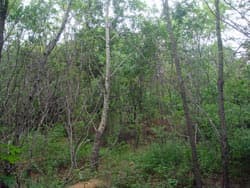 In Dong Shan Hotel: excellent cover, where small ground birds can hide, and escape from magpies
In Dong Shan Hotel: excellent cover, where small ground birds can hide, and escape from magpies
As most gardens in town are private, boosting cover like this will require promotional efforts, plus at least one demonstration site: it should be possible to show that gardens can look far more attractive than the typical, rather sterile gardens in the grounds of many hotels and sanatoriums.
[header=Woodland Conservation at the Lotus Hills, Beidaihe]
The Lotus Hills
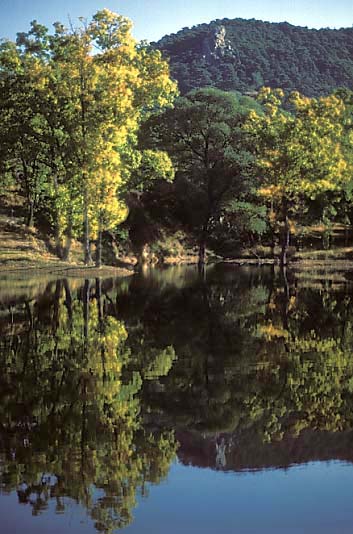 Autumn in the Lotus Hills; late 1980s.
Autumn in the Lotus Hills; late 1980s.
The Lotus Hills (Lianfengshan – Two Conjoined Hills [!]) are already protected in a park. There is woodland, dominated by conifers, and this in turn attracts woodland birds, including shy species such as owls and thrushes, which can here find some relatively undisturbed areas for feeding and resting.
The woodland here was planted early last century (Wilder 1925), prior to which the hills were evidently largely deforested. Man still has a large impact on the woods, including (at least till the 1990s) by people gathering dead grass, leaves and branches for fuel in autumn.
The woodland can be improved, to become more natural – more akin to the natural forests that would have once covered the area; only remnants of near natural forests are now found in Hebei, in hills such as at Old Peak (Laoling) north of Qinhuangdao. This might be achieved by a combination of:
• Planting native trees, shrubs and other plants – perhaps from Old Peak;
• Allowing better natural re-growth of woodland, with some species perhaps arriving naturally (in bird droppings, say). This could be achieved if harvesting of dead plant material is restricted, or halted.
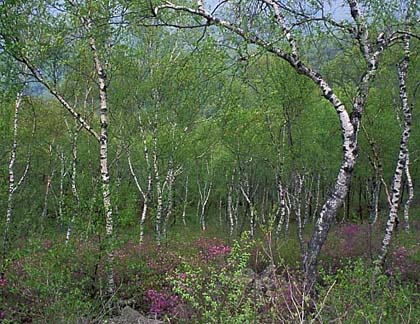 Woodland at Old Peak, 1990s.
Woodland at Old Peak, 1990s.
More natural woodland will attract more birds, including a considerably higher diversity of breeding species: breeding birds could be similar to those at Old Peak, and might likewise include globally rare Feae’s Thrush Turdus feae, and Elisae’s Flycatcher (Chinese Flycatcher) Ficedula. elisae.
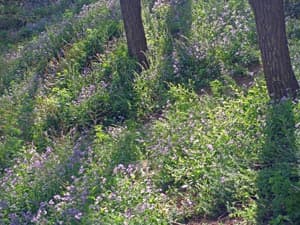 Wildflowers at Jiao Shan, Shanhaiguan
Wildflowers at Jiao Shan, Shanhaiguan
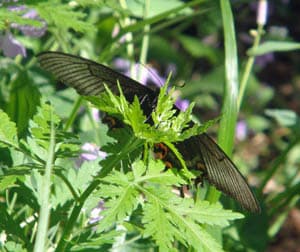 Swallowtail at Jiao Shan
Swallowtail at Jiao Shan
The enhanced bird diversity – especially the more varied songs during spring mornings will make the Lotus Hills more pleasant for visitors. So too would more varied tree and other plant species, including when these are in flower, and when deciduous trees turn to golden brown in autumn.
[header=Conservation at Daihe and Yanghe]
Daihe Area
Though the Daihe and its surrounds have long been relatively unproductive for birds, there was a superb, small pool (“Tai-Ho Pool”) just south of the Daihe mouth in 1985. Tidal, shallow, and with muddy margins, this was very attractive to wetland birds, especially shorebirds such as sandpipers.
Though the pool was since destroyed, the land it occupied has not (yet) been built on. Potentially, a pool could be created, and this and nearby coastal trees and scrub could again become a hotspot for watching migratory birds – as well as helping maintain some greenery at Nandaihe, which is otherwise mostly dominated by concrete.
Yanghe Area
Yanghe Estuary
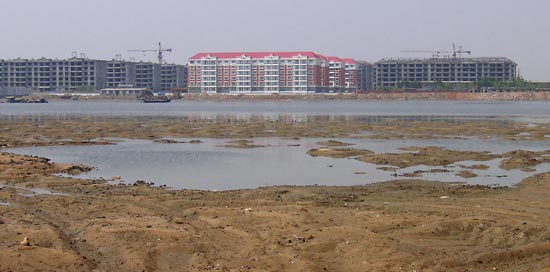 Though developments including new housing are encroaching on the Yanghe estuary, the mudflats here remain attractive to coastal shorebirds, as well as gulls, and other wetland birds including Chinese Egret. The mudflats should be retained, and the banks of the Yanghe should remain natural.
Though developments including new housing are encroaching on the Yanghe estuary, the mudflats here remain attractive to coastal shorebirds, as well as gulls, and other wetland birds including Chinese Egret. The mudflats should be retained, and the banks of the Yanghe should remain natural.
Yanghe Woods and Pools
– almost a ready-made “reserve”
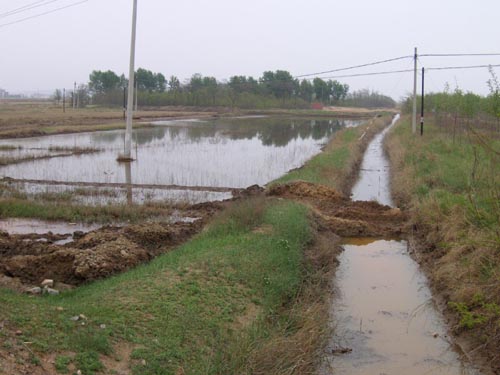 There are two small woods to the south of the Yanghe: one with fairly large trees just west of the highway, and another with mostly small trees on a small, sandy hill to the east of the road. These can hold good densities of migrant songbirds – presumably as there is little cover along this stretch of coast.
There are two small woods to the south of the Yanghe: one with fairly large trees just west of the highway, and another with mostly small trees on a small, sandy hill to the east of the road. These can hold good densities of migrant songbirds – presumably as there is little cover along this stretch of coast.
Both these woods should be retained. They could be improved if more trees/shrubs are planted within them.
 Near these woods are several small pools, including fishponds. Especially where they have shallow, muddy margins, the pools are attractive to wetland birds including egrets, ducks and shorebirds. They should be retained.
Near these woods are several small pools, including fishponds. Especially where they have shallow, muddy margins, the pools are attractive to wetland birds including egrets, ducks and shorebirds. They should be retained.
There is also a strip of damp meadow, with rough grass, used at least partly for grazing cattle. This also holds birds, including some marsh-loving wetland species – the globally near-threatened Japanese Marsh Warbler was among birds found here in May 2005.
Nearby rice paddies also hold wetland birds, sometimes including Little Curlew Numenius minutus.
This area can be protected in its current state; and perhaps improved in future.
References
Hemmingsen, A.M. (1951) Observations on birds in north-eastern China, I. Spolia Zoologica Musei Hauniensis 11: 1-227.
Hemmingsen, A.M. & Guildal, J.A. (1968) Observations on birds in north-eastern China, II. Spolia Zoologica Musei Hauniensis 28: 1-326.
Ounsted, M. (unpubl.) Proposal for a Migratory Birds’ Centre at Beidaihe, Hebei Province, China.
Wilder, G.D. (1925) Migration notes. Birds that breed in Chihli [=Hebei]. China J. Sci. Arts 3: 562-566.
Beidaihe Birding
Diary of Cambridge Ornithological Expedition to China 1985
November 1982 [while I was studying for a PhD at Cambridge University]. I had been considering arranging an expedition to study bird migration,…
Checklist of Beidaihe Birds
For species listed in Birds to Watch 2: The World List of Threatened Birds, codes used are: (CR) – critically endangered; (EN) -…
Beidaihe Can Create an Exciting Bird Reserve
[Based on speech I gave to audience inc leaders, at Beidaihe in May 2009] I first visited Beidaihe in spring 1985, as leader of…
Beidaihe Birding Notes May 2005
Just back from Beidaihe (east China) – for bird race commemorating 20th anniversary of team including me pitching up for first survey since…
Beidaihe autumns conclusions
Autumn migration at Beidaihe 1986 to 1990 conclusions Table of ContentsAutumn migration at Beidaihe 1986 to 1990 conclusionsHAZARDS FACING MIGRANT BIRDS AT BEIDAIHECONCLUDING…
Beidaihe autumn report – species accounts
Beidaihe autumn bird migration report (1986-1990): species systematically treated Table of Contents[Open][Close]Species systematically treatedBitterns, egrets and heronsSpoonbills, Ibises, StorksSwans, Geese, Shelducks and DucksRaptorsPartridges, pheasants…
Beidaihe Autumn Bird Migration Report
Autumn bird migration at Beidaihe, China, 1986-1990 (incorporating the report on China Cranewatch 1986) Edited by Martin D. Williams INTRODUCTION Martin D. Williams…
Beidaihe – Bird Migration Hub of the Orient
I first visited Beidaihe, a resort on China’s east coast, in spring 1985, and have returned each year since, mostly as leader or…



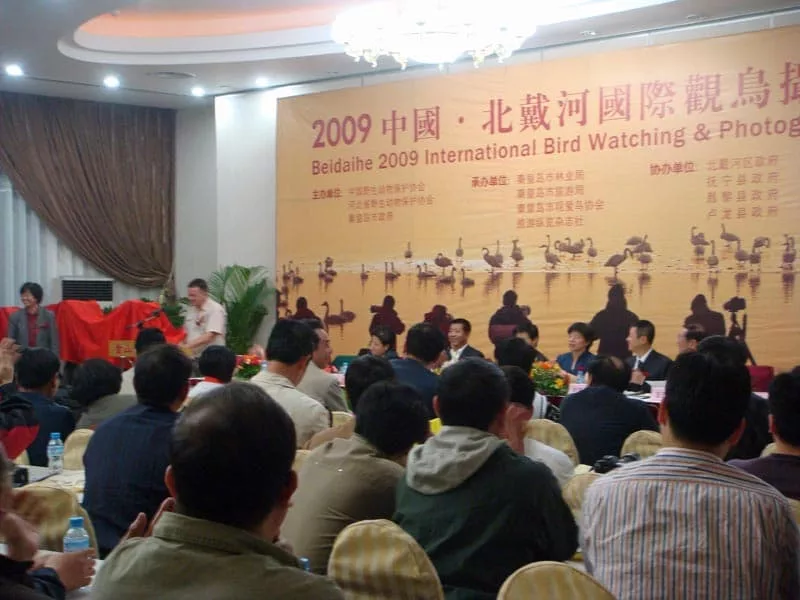
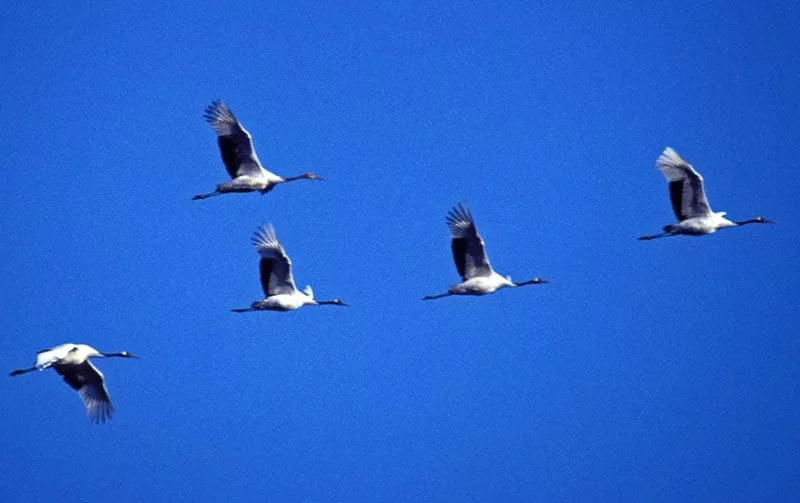
Landscape design at Beidaihe Sandflats
Though I haven't heard of anything happening directly from this plan – indeed, learned of further habitat degradation at Beidaihe – there has been something at the Sandflats, perhaps including restriction of access to Sandflats themselves.
Just been informed of this award winning landscape design project at Beidaihe. To me, looks too artificial, too much of designers at work with notion of what wild places might look like rather than what they are like (which fits Chinese gardening, really: rocks and trees to emulate fanciful mountains).
Still, better than having yet more hotels and apartment blocks!
The Qinhuangdao Beach Restoration:
An Ecological Surgery